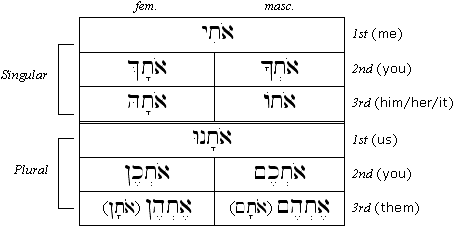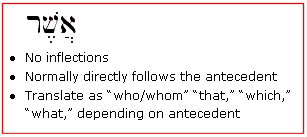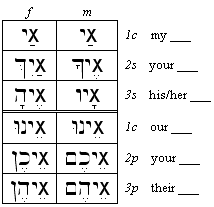|
After studying Unit Six, you should have mastered the following material:
General Properties of Pronouns
A pronoun is a word that stands in place of ("pro") a noun. The word for which a pronoun stands (or refers back to) is called the antecedent of the pronoun. Like the nouns they take the place of, pronouns have certain properties:
- Gender: Gender is a property that indicates the sex of the antecedent (masculine or feminine).
- Number: Number is the property that indicates whether the antecedent represents one (singular) or more than one (plural) object.
- Person: Person refers to the relationship between the antecedent and the speaker. A pronoun can be in the first person (I am here, We are here), second person (you are here, y'all are here), or third person (he/she/it is here, they are here).
- Case: Case indicates the grammatical function of the pronoun in a sentence. A pronoun can be a subject of a sentence (He is a king), an object in a phrase or clause (John loves her), or in a possessive relationship with an object (his Hebrew book).
Subject Pronouns
Personal pronouns can function as subjects of a verb or phrase. When functioning this way, we call them an "subject" or "independent" pronouns since they 1) function as subjects in a clause (where an implied verb "to be" is implied), and 2) they stand alone without further inflections (i.e., they are independent). For example, in the sentence "He saw Jesus ," the pronoun He functions as the subject of the verb "saw."
The following paradigm lists the forms of the personal pronoun when functioning as the subject of a clause:

Object Pronouns
The personal pronoun can function as the direct object of a verb or phrase. When functioning this way, we call it an "object pronoun." For example, in the sentence "Moses saw him," the pronoun him functions as the object of the verb "saw."
When a personal pronoun is as the object of a verb, endings are added to the definite direct object marker (et) to indicate the gender, person, and number of the object. The following paradigm lists the forms of the personal pronoun when functioning as the object of a verb:

Note that the endings for the object pronoun clearly resemble the pronomial endings for singular nouns (Unit 6.7).
Demonstrative Pronouns
Demonstrative Pronouns replace a noun by answering the question "which? In Hebrew, the demonstrative pronouns ("this-these" / "that-those") function in much the same way as they do in English. The paradigm for the demonstrative pronoun is as follows:

Demonstrative pronouns function just like predicate adjectives, and have the following properties:
- They appear before the noun they modify
- They agree with the noun they modify in:
- Gender (masc / fem)
- Number (sing / pl)
- but not in definiteness
For examples of usage, see Unit 6.4.
The Relative Pronoun
A relative pronoun (who, that, which) connects a modifying clause to an antecedent. This clause is called a relative clause since it "relates" the clause to the antecedent and modifies it adjectivally. In Hebrew, the relative pronoun asher takes no inflections (i.e., no different spellings for gender, number, or definiteness) and normally appears directly following the antecedent.

For examples of usage, see Unit 6.5.
Interrogative Pronouns
Interrogative pronouns are used to ask questions about antecedents. The most common of these are the words who? (mi) and what? (mah). Fortunately these words are not inflected for gender, number, or case, which means that once you learn the meaning of the Hebrew word, you're done.
The interrogative Hey (with a Chateph Patach) sometimes appears as the first letter of a sentence to pose a question. Since this Hey prefix can be mistaken for a definite article, when you see a Hey on the front of a word, don't just assume that it is the definite article: Look more carefully and see if it might be the interrogative Hey.
For specific usage examples of interrogatives, see Unit 6.6.
Pronomial Suffixes (Singular Nouns)
In Hebrew, possession can be expressed by attaching "pronomial" endings to nouns. For singular nouns, the endings attached to the construct form of the noun are as follows:

In the paradigm given above, note that the "X" refers to the last letter of the construct form of the noun. Also note that the final Hey in the 3sf form takes a mappiq (in 99% of the cases where you see this, translate as "her ___").
Remember that nouns with pronomial suffixes are considered definite nouns. Among other things this means that any adjective that follows the noun must take the definite article.
For additional information, including usage examples, see Unit 6.7.
Pronomial Suffixes (Plural Nouns)
In Hebrew, possession can be expressed by attaching "pronomial" endings to nouns. For plural nouns, the endings attached to noun are as follows:

In the paradigm given above, note that the "X" refers to the last letter of the noun.
Pronomial Suffixes (Verbs)
Note also that these suffixes can be attached to the ends of verbs. Morphologically, when a pronomial suffix occurs on a verb, it is generally attached to its inflected form. Semantically, the pronoun ending indicates a direct object of the verb's action.
Some Notes:
- The suffixes look somewhat like those on the ends of singular nouns but are attached to the ends of plural nouns.
- All these suffixes have a Yod stuck between the noun and the suffix. This Yod is the single element in the pronominal suffixes that let you know whether you are dealing with a singular or a plural noun (i.e., whether the word is "your horse" or "your horses").
- The 3ms suffix is a diphthong pronounced "av."
- For masculine nouns, the suffixes attach to what I am calling the "base form" of the noun, that is, the singular absolute form (with vowel changes, of course).
- For feminine nouns, the suffixes attach to the normal plural form.
For additional information, including usage examples, see Unit 6.8.
|
|








